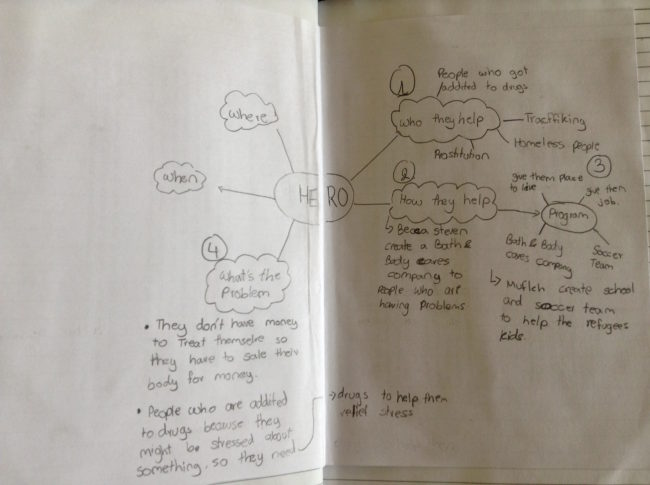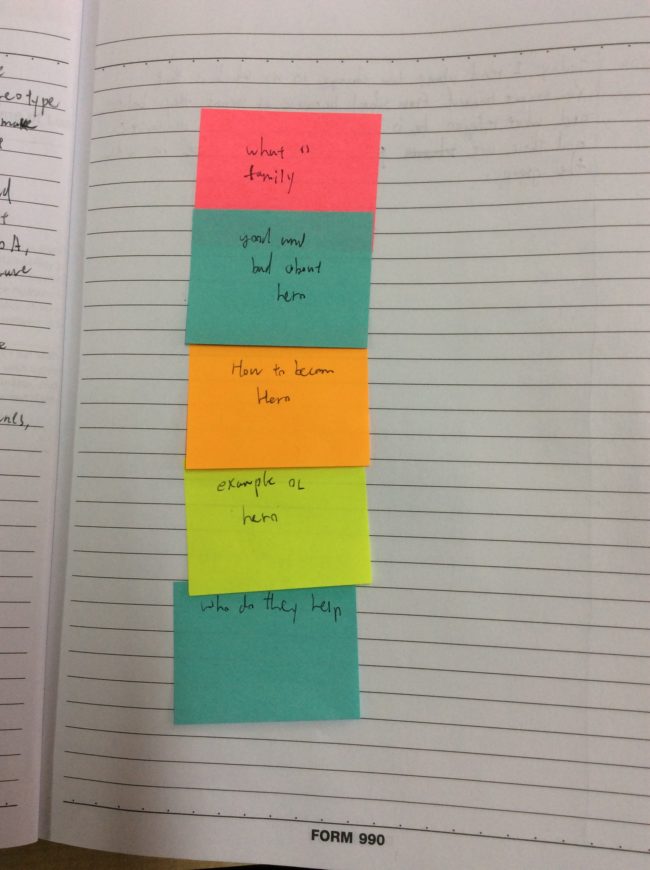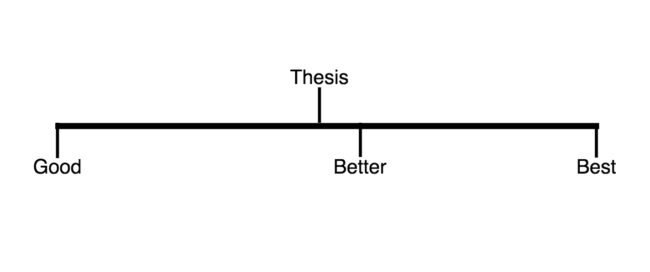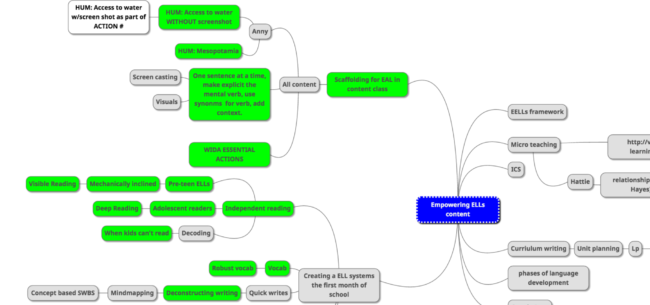
Guiding Questions
- Why is organizing ideas before drafting important?
- How can ELs develop the skill of organizing ideas?
Goal
Welcome back to this week’s article where we continue with our writing instruction posts as part of the Visible Literacy series. The goal of this post is to share different ways ELLs can outline their ideas before writing. My goal is to share the process with you and provide you with the steps.
Research Suggests
Learning is the process of engaging with new knowledge in a way that makes sense to the learner (Ausubel, 1968; Novak & Cañas, 2008).
Students internalize the information that they grapple with (Ausubel,1968; Ausubel, Novak, & Hanesian, 1978).
For example, many of my Asian students come from schools who practice a traditional approach to learning English that focuses on learning grammar rules. They were not asked to create language – just to memorize it.
When they come to my school, they might have had several years of English, but struggle to communicate ideas orally. However, when I structure the interactions in a way that facilitate the use of language, these same ELs flourish and are able to produce language because they were forced to grapple with language instead of memorizing it.
Outlining empowers ELs to grapple with their ideas. It helps them write effectively because they are actively forming the connections between the ideas. Since outlining doesn’t require a large amount of text to create, it frees ELs to make connections and organize ideas without being restrained by grammar and mechanics (Chularat & DeBacker, 2004). Those details will come at the revision and editing stages.
Past Practices
Mistake: Supplying Teacher-Made Outlines
Once students understood the writing prompt, I used to give them a fully produced outline that contained all the main points I expected to be included in their essays. Each paragraph had a list of bullet points to be covered. There were even guiding questions to help students craft the introductions and conclusions.
I thought I was doing my job well. Wrong!
My highly structured outline only helped students submit work, but the work was of poor quality. The ideas were disconnected, few insights were made, and the tone reads inauthentically.
Unfortunately, giving students an outline turned out to be a poor literacy practice because the ELs were not invited to struggle through the organization of their ideas.
When ELs organize ideas by themselves, it helps internalize the writing process. Furthermore, ELs do not learn to write academic text from an outline because the process is not modeled to them. They see only the end product, not the steps to get there.
Current Practices
Modeling the Process
Over the past few years, I have changed my approach and began to show my students the process of writing, one phase at a time, and allowing them to produce a section of text immediately after the modeling. We’ve already described the first step of the “Visible Writing” process, deconstructing the writing prompt, in the previous post.
Organizing Ideas
Having analyzed the writing prompt and after completing the mind-mapping of their initial ideas, the ELs begin organizing the thoughts they’ve produced in the mind maps. No additional brainstorming is needed. Now it’s time to organize these ideas into a logical order that effectively communicates a coherent message.
I will share four methods of organizing ideas below. They are listed in order of the least modeling required by the teacher to the most.
Method 1: Numbering the Mind Map
Now that the ELs have a mind map with ideas, they can simply number the ideas in the order in which they want to write the essay. This works best with students whose mind maps are barely completed. If they are unable to generate more ideas, forcing them to do so causes great frustration.
I honor the work they have given thus far by modeling how to organize their ideas using their existing mind maps, even if they have only a few ideas. This empowers them to organize what notes they have in a simple way so that they are encouraged to formulate more.
In this method, I ask students to look at their mind map and consider which point they want to be first. The student uses a pencil and marks “#1” on that point. Then I ask the EL what point do they want to communicate after #1. Now that there are two points, I ask the EL for their reasoning for organizing it this way. The student explains, and then I ask what would make sense after point # 2.? We continue this process until all the points have been ordered.
What are the other students doing as I am modeling? I ask them to observe the steps that I’m teaching the student volunteer. After the modeling is over, I will ask the observers to identify the steps. Setting this expectation helps them become active observers and develops their meta-cognitive thinking skills. Learning a language is an opportunity to teach both language and thinking .

Mina’s numbered outline
You will see in my video when I collaborated with Mina on numbering her mind map that I didn’t ask Mina for her logic. That was a missed opportunity to develop critical thinking and the chance to emphasize the process. It’s really important to ask students for their logic behind their organization. This emphasizes a need for connections between ideas and internalizes the concept that the priority of writing is to clearly communicate your ideas in a logical way.
On a side note, the practice of recording oneself teaching and then debriefing the clip to analyze areas of strengths and areas of growth is called micro-teaching. Education statistician, John Hattie, cited that one of the top ten teaching practices that have the greatest impact on students’ achievement is microteaching (2012).
Sebastian’s Visible Learning website is the MOST extensive resource on all of Hattie’s top ten practices if you are interested in investigating more. I’ll write more extensively about Hattie’s research in another series.
Method 2: Sticky Noting
The next method, Sticky Noting, works best with a student whose mind map is overflowing with ideas. Often a student has plenty of ideas, but there’s no order to them. This can feel debilitating to ELs because there are so many ideas to start with. The sticky notes, however, make starting writing a more concrete and manageable task.
Again, I have students form a fishbowl around me and the volunteer student. I ask the student to identify ONE point that he wants to communicate. We write that point on a sticky note and continue until all the points are each on a sticky note. Then I ask the student which of these points should be communicated first.
We place it on a page in the EL’s English notebook. After that, I ask the EL which of the remaining points would make sense after the idea numbered as “one”. I have the EL place that second point right after the first one. We continue until all the points are now arranged in an order that makes sense to the EL.
After watching Jane and I model the practice, Kazuya decided to use this method. This is his outline for his “Heroes” essay using the sticky note method.
 I actually praise my ELs when they decide to rearrange their sticky notes after the initial placement because it demonstrates that they’re thinking and internalizing the concept of organizing ideas.
I actually praise my ELs when they decide to rearrange their sticky notes after the initial placement because it demonstrates that they’re thinking and internalizing the concept of organizing ideas.
Method 3: Mind Mapping with Software
The third method is using a free mind mapping software called Mind Mup to support ELs as they organize their writing. I am in love with mind maps, so I find ways to incorporate them as much as possible (without going overboard). Mind Mup is absolutely frictionless when it comes to integrating with Google Drive. My students can even save their Mind Mups and link them directly to their Google Drive accounts.
I invite a student whose mind map is adequately full, but not brimming or starved of ideas to volunteer to be my modeling partner. I project what I’m doing with the student onto the board so everyone can visually see our process.
The student identifies one point they want to communicate, and I create a bubble to capture that point in the Mind Mup program. Then, I ask the student what’s the next point they want to communicate. The student identifies it, and I add it to the Mind Mup. We continue this process until all the points are captured on the Mind Mup.
Mind Mup allows students to move a bubble around, link it to another bubble, or add another detail to the bubble. The flexible nature of mind mapping with an online program helps the students who have some ideas but not enough to generate more. This method is essentially like Method 1, but with an online software program.
None of my students decided to use the Mind Mup method for this writing assignment, but I still wanted show you an example. The image below is my actual Mind Mup that outlines the content for my blog. What you’re seeing in the 12th version of it, and that’s why I like this method. I can change the outline as many times as needed.
Method 4: Linear Outlining
Mind mapping is a nonlinear way to organize ideas and works best with ELs who are visually inclined,abstract thinkers. But for the linear thinkers in the room, the free-flowing nature can be off-putting and alienating, so I also offer a more traditional approach to organizing ideas.
Again, I invite a student to be part of the modeling process. The rest of the class forms a fishbowl as they watch me model for the student volunteer.
We begin by asking the student what is the main point they are trying to prove. The student shares it, and I write it at the top of the page in the student’s English notebook.
Then I draw a line below the thesis on the same page. Then I draw three points on the line starting with “Good” at the beginning of the line, “Better” at the middle point of the line, and “Best” at the end of the line. This is what the diagram looks like this:

The “Good, Better, Best” diagram for outlining linearly.
After that, I ask the student to identify a point that is “good”, and this means that the EL has appropriate evidence to support the thesis. I write it below the “Good”. Then I ask the student to identify a point that is a better than the ideas in the “Good section. We write that below the “Better” section.
Finally, I ask the learner to identify the best idea that would support her thesis. Now I let her write it below the “Best” section to gradually release the responsibility to her. The modeling process should empower the ELs to be independent learners.
The “Good, Better, Best” progression really helps ELs internalize the concept of organizing because it provides a framework for evaluating ideas. Frameworks provide ELs with a safe, structured environment to master skills and internalize concepts.
Talk as “Draft Writing”
Now that they have an outline of their ideas, allow them to orally present their outline. This provides an opportunity for ELs to switch from the informal register to a more formal, academic one that is expected at schools and work settings. Talking allows them to orally draft their ideas, and when it’s time to craft writing, they are more likely to succeed (Bedi, 2016).
To structure the sharing, the listeners must note the order in the presenter’s outline. The students who are listening to them must feed back their notes to the presenting student.
Modeling Leads to Learning
All of these methods of organizing have two things in common: teacher-based modeling and student-led construction. Modeling makes the process visible by providing clear, identifiable steps .
Subsequently, ELs are not asked to follow a prescribed outline by the teacher, but rather are empowered to pick the process that works best for them. ELs should not be treated as machines mindlessly creating language. Instead, they should be encouraged to be participants in the process.
Indeed, my students tell me that once I started to include them in this way, they felt like I was right there with them!
Sitting right beside them, aiding their learning process instead of lecturing to them. They felt more capable and empowered to use this skill in other classes.
I am most proud when the responsibility of thinking and the joy of being creative remain part of the students’ own processes.
They are the writers.
Takeaways
- Organizing ideas before writing supports ELs in creating text.
- Organizing is an invisible process.
- Organizing ideas can be modeled for ELs, demonstrating both traditional linear outlining and various nonlinear methods.
Next Week
If you have followed this series, we have learned about Quick Writing, deconstructing the writing prompt, and now organizing ideas. Thank you for taking the time to read this article. I hope it was helpful to you and your practice.
In next week’s post, we will learn a process to help ELs compose text: using their mind maps of organized ideas to actually form sentences and paragraphs that communicate a central message.
 References
References
Ausubel, D.P. (1968). Educational psychology: A cognitive view. New York: Holt, Rinehart and Winston.
Ausubel, D.P., Novak, J.D., & Hanesian, H. (1978). Educational psychology: A cognitive view (2nd ed.). New York: Holt, Rinehart and Winston.
Bedi, I. (2016). Scaffolding Writing Across the Curriculum: An EAL Approach. Penarth, UK: Dragonfly EAL.
Chamot, A. U., & O’Malley, J. M. (1994). The CALLA handbook: Implementing the Cognitive Academic Language Learning Approach. Reading, MA: Addison-Wesley.
Chularat, P., & DeBacker, T.K. (2004). The influence of concept mapping on achievement, self-regulation, and self-efficacy in students of English as a second language. Contemporary Educational Psychology, 29, 248-263.
Cummins, J. (1991). Language Development and Academic Learning. In L. Malave and G. Duquette (Eds.), Language, Culture and Cognition. Clevedon: Multilingual Matters.
Hattie, J. (2012). Visible learning for teachers: Maximizing impact on learning. London: Routledge.
Novak, J.D. & Cañas, A.J. (2008). The theory underlying concept maps and how to construct and use them. Retrieved from:http://cmap.ihmc.us/publications/researchpapers/theorycmaps/theoryunderlyingconceptmaps.htm
Schleppegrell, M. J. (2004). The language of schooling: A functional linguistics perspective. Mahwah, NJ: Lawrence Erlbaum.


